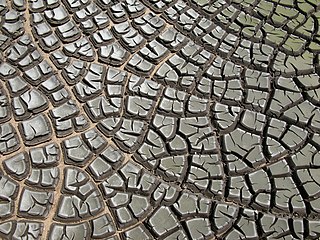
Sewage sludge is the residual, semi-solid material that is produced as a by-product during sewage treatment of industrial or municipal wastewater. The term "septage" also refers to sludge from simple wastewater treatment but is connected to simple on-site sanitation systems, such as septic tanks.

The activated sludgeprocess is a type of biological wastewater treatment process for treating sewage or industrial wastewaters using aeration and a biological floc composed of bacteria and protozoa. It uses air and microorganisms to biologically oxidize organic pollutants, producing a waste sludge containing the oxidized material.

Sewage sludge treatment describes the processes used to manage and dispose of sewage sludge produced during sewage treatment. Sludge treatment is focused on reducing sludge weight and volume to reduce transportation and disposal costs, and on reducing potential health risks of disposal options. Water removal is the primary means of weight and volume reduction, while pathogen destruction is frequently accomplished through heating during thermophilic digestion, composting, or incineration. The choice of a sludge treatment method depends on the volume of sludge generated, and comparison of treatment costs required for available disposal options. Air-drying and composting may be attractive to rural communities, while limited land availability may make aerobic digestion and mechanical dewatering preferable for cities, and economies of scale may encourage energy recovery alternatives in metropolitan areas.

Green waste, also known as "biological waste", is any organic waste that can be composted. It is most usually composed of refuse from gardens such as grass clippings or leaves, and domestic or industrial kitchen wastes. Green waste does not include things such as dried leaves, pine straw, or hay. Such materials are rich in carbon and considered "brown wastes," while green wastes contain high concentrations of nitrogen. Green waste can be used to increase the efficiency of many composting operations and can be added to soil to sustain local nutrient cycling.

The Nocardiaceae are a family of aerobic, non-fastidious, high G+C, Gram-positive actinomycetes that are commonly found in soil and water. Members of this family have been isolated from Antarctic soils. Nocardiaceae present coccobacilli, filamentous or, rarely, fragmented and palisading forms, and filamentous species grow in a branching morphological pattern similar to fungal hyphae.

Sewage treatment is a type of wastewater treatment which aims to remove contaminants from sewage to produce an effluent that is suitable to discharge to the surrounding environment or an intended reuse application, thereby preventing water pollution from raw sewage discharges. Sewage contains wastewater from households and businesses and possibly pre-treated industrial wastewater. There are a high number of sewage treatment processes to choose from. These can range from decentralized systems to large centralized systems involving a network of pipes and pump stations which convey the sewage to a treatment plant. For cities that have a combined sewer, the sewers will also carry urban runoff (stormwater) to the sewage treatment plant. Sewage treatment often involves two main stages, called primary and secondary treatment, while advanced treatment also incorporates a tertiary treatment stage with polishing processes and nutrient removal. Secondary treatment can reduce organic matter from sewage, using aerobic or anaerobic biological processes.
Extended aeration is a method of sewage treatment using modified activated sludge procedures. It is preferred for relatively small waste loads, where lower operating efficiency is offset by mechanical simplicity.
Acidovorax caeni is a gram-negative, catalase- and oxidase-positive, rod-shaped bacterium from the Comamonadaceae family that was isolated from the activated sludge of a wastewater treatment plant in Belgium. Colonies are yellow–brown.
Hydrogenophaga caeni is a Gram-negative, anaerobic, catalase- and oxidase-positive, motile bacterium from the Comamonadaceae family, with a single polar flagellum, which was isolated from an activated sludge. Colonies of H. caeni are white colored.
Castellaniella caeni is a Gram-negative, oxidase-positive, catalase-negative, facultatively anaerobic, denitrifying, nonmotile bacterium from the genus Castellaniella, isolated from the sludge of the aerobic treatment tanks of a municipal leachate treatment plant in Daejeon in the Republic of Korea.
Zoogloea caeni is a gram-negative, catalase and oxidase-positive, facultatively aerobic, nitrogen-fixing, rod-shaped motile bacterium with a polar flagellum from the genus of Zoogloea which was isolated from activated sludge of a domestic wastewater treatment plant in Korea.
Daeguia caeni is a Gram-negative, non-spore-forming bacterium from the genus Daeguia, which was isolated from sludge of a textile dye works in Daegu in Korea.
Chryseobacterium caeni is a Gram-negative and non-spore-forming bacteria from the genus Chryseobacterium which has been isolated from bioreactor sludge in Daejeon in Korea.
Nocardioides daejeonensis is a gram-positive, denitrifying, rod-shaped, aerobic and non-motile bacterium from the genus Nocardioides that has been isolated from a sewage disposal plant in Daejeon, South Korea.
Gordonia cholesterolivorans is a bacterium from the genus Gordonia which has been isolated from sewage sludge from a sewage treatment plant in Ciudad Real in Spain. Gordonia cholesterolivorans has the ability to degrade cholesterol.
Gordonia malaquae is a bacterium from the genus Gordonia which has been isolated from sludge from a wastewater treatment plant in Taiwan.
Chelatococcus caeni is a Gram-negative, non-spore-forming, rod-shaped and motile bacterium from the genus of Chelatococcus which has been isolated from biofilm reactor sludge in Korea.
Rhodanobacter caeni is a Gram-negative and motile bacterium from the genus of Rhodanobacter which has been isolated from sewage sludge from Daejeon in Korea.
Pseudoclavibacter caeni is a Gram-positive, strictly aerobic, rod-shaped and non-motile bacterium from the genus Pseudoclavibacter which has been isolated from sludge from a sewage plant from Daejeon in Korea.






